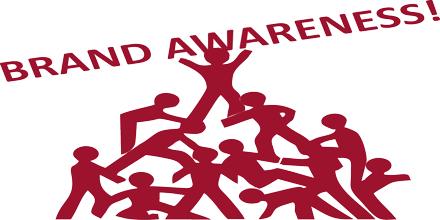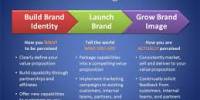Brand Awareness is pretty easy to define in abstract, but it is less easy to attain. It is a key consideration in Consumer Behaviour and Advertising strategy. Brand awareness refers to the extent to which customers are able to recall or recognise a brand. The consumer’s ability to recognise a brand is central to purchasing decision-making. Awareness does not necessarily mean that the consumer must be able to recall a specific brand name, but he or she must be able to recall enough distinguishing features for purchasing to proceed. For instance, if a consumer asks her friend to buy her some gum in a “blue pack”, the friend would be expected to know which gum to buy, even though neither friend can recall the precise brand name at the time.
Importance of Brand Awareness
Brand awareness is related to the functions of brand identities in consumers’ memory and can be reflected by how well the consumers can identify the brand under various conditions. Brand awareness is also central to understanding the consumer purchase decision process. Strong brand awareness can be a predictor of brand success. It is an important measure of brand strength or brand equity and is also involved in customer satisfaction, brand loyalty and the customer’s brand relationships.
Brand awareness is a key indicator of a brand’s market performance. Every year advertisers invest substantial sums of money attempting to improve a brand’s overall awareness levels. Many marketers regularly monitor brand awareness levels, and if they fall below a predetermined threshold, the advertising and promotional effort is intensified until awareness returns to the desired level. Setting brand awareness goals/ objectives is a key decision in marketing planning and strategy development.
Aaker, 1991a argued that, in order to build a brand and maintain brand equity, brand awareness is one of four major brand assets that add value to the product, service or its customers. Investments in brand awareness can lead to sustainable competitive advantages, thus, leading to long-term value.
Types of Brand Awareness
Different types of brand awareness can be identified:
Brand recall (also known as unaided recall or spontaneous recall): refers to the ability of the consumers to correctly elicit a brand name from memory.
Brand recognition(also known as aided recall): refers to the ability of the consumers to correctly differentiate the brand when they come into contact with it. This does not necessarily require that the consumers identify the brand name. Instead, it means that consumers can recognise the brand when presented with it at the point of sale or after viewing its visual packaging.
Top-of-Mind Awareness: Top-of-mind awareness is defined as “the first brand that comes to mind when a customer is asked an unprompted question about a category. At the market level, however, top-of-mind awareness is more often defined as the “most remembered” or “most recalled” brand names.
A brand that enjoys top-of-mind awareness will generally be considered as a genuine purchase option, provided that the consumer is favourably disposed to the brand name. Top-of-mind awareness is relevant when consumers make a quick choice between competing brands such as for low-involvement, impulse type purchases.
Brand recall indicates a relatively strong link between a category and a brand while brand recognition indicates a weaker link. When prompted by a product category, most consumers can only recall a small set of brands, typically around 3-5 brand names (although heavy users or enthusiasts may recall more brand names). However, most consumers can recognise a larger set of brands, when prompted. Clearly brand awareness is closely related to the concepts of the evoked set (defined as the set of brands that a consumer can elicit from memory when contemplating a purchase) and the consideration set (defined as the “small set of brands which a consumer pays close attention to when making a purchase decision”. After searching for information about a category, consumers may become aware of a large number of brands which collectively are known as the awareness set. However, consumers need to be favourably disposed to brands before they will be considered as realistic purchase options.
Percy and Rossister (1992) argue that brand recall and brand recognition operate in fundamentally different ways in the purchase decision. For purchases such as fast moving consumer goods (FMCG), few shoppers carry shopping lists. For them, the presentation of brands at the point-of-sale acts as a visual reminder and triggers category need. In this case, brand recognition is the dominant mode of awareness. For other purchases, where the brand is not present, the consumer first experiences category need then searches memory for brands within that category. Many services, such as home help, gardening services, pizza delivery fall into this category. In this case, the category need precedes brand awareness. Such purchases are recall dominant, and the consumer is more likely to select one of the brands that elicited from memory. The distinction between brand recall and brand recognition has important implications for advertising strategy.
Measuring Brand Awareness
Just as different types of brand awareness can be identified, there are a variety of methods for measuring awareness. Typically, researchers use surveys, carried out on a sample of consumers asking about their knowledge of the focus brand or category.
Two types of recall test are used to measure brand awareness:
Unaided recall tests: where the respondent is presented with a product category and asked to nominate as many brands as possible. Thus, the unaided recall test provides the respondent with no clues or cues. Unaided recall tests are used to test for brand recall.
Aided recall test: where the respondent is prompted with a brand name and asked whether they have seen it or heard about it. In some aided recall tests, the respondent might also be asked to explain what they know about the brand e.g. to describe package, colour, logo or other distinctive features. Aided recall tests are used to test for brand recognition.
Other brand-effects tests: In addition, to recall tests, brand research often employs a battery of tests, such as brand association tests, brand attitude, brand image, brand dominance and any other relevant tests. Although these tests do not explicitly measure brand awareness, they provide general measures of brand health and are used in conjunction with brand recall tests.
A number of commercial research firms (e.g. Interbrand, Millward-Brown, Nielsen (Asia)) monitor brand effects on for key international brands and the topline survey findings are widely published in business press, trade press and online. It is worth noting that these commercially compiled lists are not popularity contests, but use clearly articulated methodologies to compile lists based on consumer responses collected in structured research. However, these listings use a variety of metrics, so the results are not directly comparable and it cannot be assumed that they measure brand awareness. As with the interpretation of all research, it is important for readers to familiarise themselves with the methodologies used in order to clarify what exactly is being measured and how the data was collected.
Obviously, most marketers aim to build high levels of brand awareness within relevant market segments, so there is an ongoing interest in developing the right metrics to measure brand effects. Metrics used to measure brand effects are collectively termed AAU metrics (Awareness, Attitudes and Usage).
Brand dominance occurs when, during brand recall tests, most consumers can name only one brand from a given category. Brand dominance is defined as an individual’s selection of only certain brand names in a related category during a brand recall procedure. While brand dominance might appear to be a desirable goal, overall dominance can be a double-edged sword.
A brand name that is well known to the majority of people or households is also called a household name and is an indicator of success. Occasionally a brand can become so successful that the brand becomes synonymous with the category. For example, British people often talk about “Hoovering the house” when they actually mean “vacuuming the house.” (Hoover is a brand name). When this happens, the brand name is said to have “gone generic.” Examples of brands becoming generic abound; Kleenex, Cellotape, Nescafe, Aspirin and Panadol. When a brand becomes generic, it can present a marketing problem because when the consumer requests a named brand at the retail outlet, they may be supplied with a competing brand. For example, if a person enters a bar and requests “a rum and Coke,” the bartender may interpret that to mean a “rum and cola-flavoured beverage,” paving the way for the outlet to supply a cheaper alternative mixer. In such a scenario, Coca Cola Ltd, who after investing in the brand building for more than a century, is the ultimate loser because it does not get the sale.
Brand Awareness and the Hierarchy of Effects
The Hierarchy of Effects is a model which proposes that customers progress through sequential stages from brand awareness through to the purchase of a product.
Stage 1: ‘Awareness ‘ – The consumer becomes aware of a category, product or brand (usually through advertising)
Stage 2: ‘Knowledge’ – The consumer learns about the brand (e.g. sizes, colours, prices, availability etc)
Stage 3: ‘Liking’ – The consumer develops a favourable/unfavourable disposition towards the brand
Stage 4: ‘Preference’ – The consumer begins to rate one brand above other comparable brands
Stage 5: ‘Conviction’ – The consumer demonstrates a desire to purchase (through inspection, sampling or limited scale trial)
Stage 6: ‘Purchase’ – The consumer acquires the product
The model’s developers noted that the first two stages involve cognitive processes; stages 3 and 4 involve attitudes (or feelings) while the final stages involve action (or behaviours). It should be evident that brand awareness constitutes just one of six stages that consumers typically work through. While awareness is a necessary precondition to the purchase, awareness alone cannot guarantee the ultimate purchase. Consumers may be aware of a brand, but for whatever reasons, may not be like it or may fail to develop a preference for that brand. Hence, brand awareness is an indicator of sales performance, but does not account for all sales performance. For these reasons, marketers use a variety of metrics, including cognitive, affective and behavioural variables, to monitor a brand’s market performance.
As consumers move through the hierarchy of effects (awareness→ knowledge→ liking→ preference→ conviction→ purchase), they rely on different sources of information to learn about brands. While main media advertising is useful for creating awareness, its capacity to convey convey long or complex messages is limited. In order to acquire more detailed knowledge about a brand, consumers rely on different sources such as product reviews, expert opinion and brand/ corporate websites. As consumers move closer to the actual purchase, they begin to rely on more personal sources of information such as recommendations from friends and relatives or the advice of sales representatives. For example, the opinion of an influential blogger might be enough to shore up preference/conviction while a salesperson might be necessary to close the actual purchase.
Creating and Maintaining Brand Awareness
Brand advertising can increase the probability that a consumer will include a given brand in his or her consideration set. Brand-related advertising expenditure has a positive affect on brand awareness levels. Virtually anything that exposes consumers to a brand increases brand awareness. “Repeat brand exposure in stores improves consumers’ ability to recognize and recall the brand.” Increased exposure to brand advertising can increase consumer awareness and ‘facilitate consumer processing of the included information, and by doing this it can heighten consumers brand recall and attitude towards the brand.
Traditionally, marketers created high levels of brand awareness through intensive advertising campaigns. To be successful, an intensive campaign utilised both broad reach (expose more people to the message) and high frequency (expose people multiple times to the message). Advertising, especially main media advertising, was seen as the most cost efficient means of reaching large audiences with relatively high frequency levels. Marketers often relied on rough and ready ‘rules-of-thumb’ to estimate the amount of advertising expenditure required to achieve a predetermined level of awareness. For instance, it was often held that to increase brand awareness by just one per cent, it was necessary to double the dollars spent on advertising.
While advertising remains important for creating awareness, a number of changes in the media landscape and to consumer media habits have reduced the reliance on main media advertising. Instead, marketers are seeking to place their brand messages across a much wider variety of platforms. An increasing amount of consumer time and attention is devoted to digital communications devices – from social media networks through to cellphones. It is now possible to engage with consumers in a cost efficient manner using platforms such as social media networks that command massive massive audiences. For example, Facebook has become an extremely important communications channel. Moreover, social media channels allow for two-way, interactive communications that are not paralleled by traditional main media. Interactive communications provide more opportunities for brands to connect with audience members and to move beyond simple awareness, facilitating brand preference, brand conviction and ultimately brand loyalty.
When a brand becomes established and attains the desired awareness levels (typically outlined in the marketing plan), the brand advertiser will shift from an intensive advertising campaign to a reminder campaign. The objective of a reminder campaign is simply to keep relevant audiences aware of the brand’s existence and to introduce new life into the brand offer. A reminder campaign typically maintains broad reach, but with reduced frequency and as a consequence is a less expensive advertising option. Reminder advertising is used by established brands which are entering the maturity stage of the product lifecycle.
The rise of social media networks has increased the opportunities for opinion leaders to play a role in brand awareness. In theory, anyone can be an opinion leader e.g. celebrities, journalists or public figures, but the rise of the digital environment has changed our understanding of who is a potentially useful influencer. Indeed the digital environment has created more opportunities for bloggers to become important influencers because they are seen as accessible, authentic and tend to have loyal followings. Bloggers have become key influencers in important consumer goods and services including fashion, consumer electronics, food and beverage, cooking, restaurant dining and bars. For example, a recent survey by by Collective Bias, showed that when it comes to product endorsements digital influencers are more popular than celebrities. Findings showed that only 3% of participants said they would consider buying a celebrity-endorsed item, in comparison to 60% who said they had been influenced by a blog review or social media post when shopping. For marketers, the digital landscape has made it somewhat easier to identify social influencers.
















